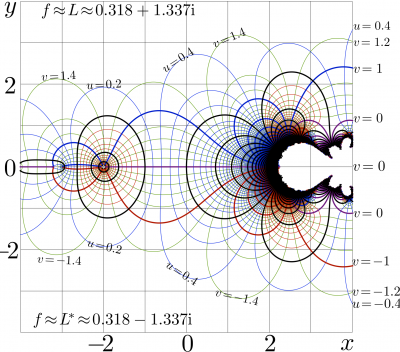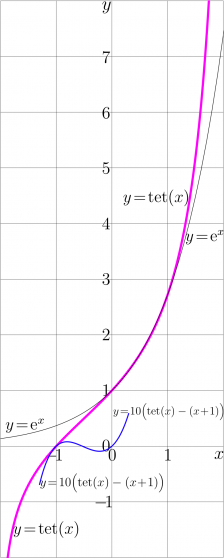Natural tetration
Natural tetration is tetration to the base $\mathrm e=\exp(1)\approx 1.71~$.
Natural tetration is denoted as $\mathrm {tet}$ or $\mathrm {tet}_{\mathrm e}$; it satisfies the transfer equation
- $\exp(\mathrm{tet}(z))= \mathrm{tet}(z\!+\!1)$
Also the initial condition
- $\mathrm{tet}(0)=1$
is assumed.
The asymptotic behavior at large values of the imaginary part of the argument is exponential approach the fixed point of logarithm
- $\!\!\!\!\!
L=\mathrm{Filog}(1)\approx 0.318131505204764135312654+1.33723570143068940890116\, i $ in the upper half-plane and $L^*$ in the lower half-plane. See the spacial article Filog.

Natural tetration can be evaluated with the Iterated Cauchi algorithm.
Along the real axis, the natural tetration shows fast growth, faster than any exponential and faster than any finite combinaiton of exponentials.
Function $\mathrm {tet}(z)$ is holomorphic in the whole complex plane except the line $\Re(z)\le -2$. Due to the wide range of holomorphism, and the simple properties, tetration is most important among various superfunctions of the exponential; an other supedfunciotn can be expressed with
- $\mathrm{sexp}(z)=\mathrm{tet}(z+\eta(z))$
where $\eta$ is holomorphic periodic function with period unity, The exponential growth of $\eta(z)$ in the direction of the imaginary axis reduces the range of holomorphism of such a superexponential, destroying its apymptotic approach to $L$ and $L^*$.
Inverse of the natiral tetration is denoted with symbol $\mathrm {ate}=\mathrm {tet}^{-1}$.
The pair of functions $\mathrm {tet}$ and $\mathrm{ate}$ allows the efficient evaluation of the iteration of exponential,
- $\exp^c(z)=\mathrm{tet}(c+\mathrm{ate}(z))$
The number $c$ of iterations has no need to be integer; in particular, it can be a fration, an irrational number of even a complex number.
The non–integer iterations of exponential give the class of functions that grow faster than any polynomial but slower than any exponential.
Keywords
Tetration, Superfunction, Transfer equation, Exponential, fixed point
References
http://www.ams.org/mcom/2009-78-267/S0025-5718-09-02188-7/home.html D.Kouznetsov. (2009). Solutions of F(z+1)=exp(F(z)) in the complex plane.. Mathematics of Computation, 78: 1647-1670. DOI:10.1090/S0025-5718-09-02188-7.
http://www.ils.uec.ac.jp/~dima/PAPERS/2010vladie.pdf D.Kouznetsov. Superexponential as special function. Vladikavkaz Mathematical Journal, 2010, v.12, issue 2, p.31-45.
http://www.springerlink.com/content/u7327836m2850246/ H.Trappmann, D.Kouznetsov. Uniqueness of Analytic Abel Functions in Absence of a Real Fixed Point. Aequationes Mathematicae, v.81, p.65-76 (2011)
